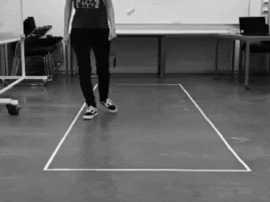The SOUNDMAT
RIXC Art Science Festival,
Mind UX Architecture blog.
Published
10 weeks
Duration
Tools
Wizard of Oz, Miro, Soundplant47
Literature review, user research, structured interviews, questionnaire, affinity mapping, cultural probes, full-body sketching, wireframing, prototyping, user-testing
Methods
The SOUNDMAT is a sonic and kinesthetic sketching tool for architects. The prototype allows architects to place sounds in a space using an app, then experience the soundscape in an immersive environment, using the experience as a guide for their designs. This project is grounded on a critique of ocularcentrism, which is a dominant design paradigm in architecture.
The prototype consists of a mobile app and an immersive environment. The immersive environment consists of a floormat equipped with pressure sensors and a pair of wireless headphones.
Problem domain
Our experience of space is embodied and situated - plus, we experience space with all senses.
Despite that, traditional architectural design tools:
Are exclusively visual
Can only afford designing from a disembodied perspective
This led to this research question:
How can embodied interaction methods provide alternatives that enrich the sight-dominated process of architectural ideation?
Design Model
Custom model, inspired by design thinking and Krogh et al’s drifting
Krogh et al’s (2015) serial way of drifting
consists of design experiments that happen in a sequential order
5 phases inspired by design thinking (empathize: project formation, define: exploration, ideate: conceptual discovery, prototype: synthesis & detailed design, test: thesis completion)
Short summary of my design process
I conducted a preliminary literature review and laid out the project’s theoretical foundations.
I conducted 6 structured expert interviews that confirmed my original hypothesis: architects would like to employ embodied design methods and tools to enrich their design process, but do not know how.
I moved on to a more extensive literature review, gathering related design examples.
I designed an online questionnaire with aleatory elements to discover what my target group would like to see in an embodied design tool, as well as their needs and frustrations when it comes to using experimental tools.
I sent out 6 cultural probes with several creative tasks, each connecting the architectural design process with a different sense modality.
I synthesized all insights from previous activities and did some full-body sketching.
I evaluated all produced sketches to pick one final concept.
I produced a prototype and did user-testing to evaluate it.
My design process, step by step:
Structured interviews
A design activity for user-research
Interviewees:
5 architects (common practitioners)
studied/ practiced architecture in 4 countries
Here are the key insights:
All participants use visual methods to sketch, only 2 were familiar with embodied design but do not employ such methods
They would like to overcome the limitations of ocularcentric design but do not know how
Online Questionnaire with aleatory elements
80 respondents from 24 different countries
Aiming to identify:
what spaces the respondents design at work [residential buildings]
what tools/ methods they use to do so [visual means]
what senses/ feelings they would like to regulate in their designs [touch, hearing, kinesthesia/ safety & pleasure]
what they need from a new design tool [it should be possible to use it both at the workplace & the site]
what they fear about using an experimental design tool [it would be hard to communicate their designs to contractors & engineers]
I wanted to find a way to prompt honest, meaningful answers, instead of sophisticated ones. Plus, I wanted to explore several sense modalities, and not just one.
As a result, I presented 6 different scenarios, and each participant chose theirs after rolling the dice. This aleatory element was consciously chosen to make the formal process of the survey more interesting, ensuring participation.
After choosing a scenario, the participant had to identify the senses/ affects involved in the experience, and if these identified senses/ affects would be easy to communicate using traditional architectural methods.
6 architects, have practiced in 5 different countries
Cultural Probes
Probe activities
3 creative tasks and 1 evaluation task over the course of 5 days
The probes served as an experiment that would examine certain hypotheses about:
the relations between sense and affect in space
how much information certain senses can convey about space.
DAY 3 showed the most potential:
The participants listen to a sound
Imagine the space where that sound would be heard
design that space using visual means
Most participants guessed right - it was a person walking down the stairs.
Ambiguity in terms of dimensions and materials proved that:
Sound is an excellent sketching material. It can convey crucial information about a space while maintaining a level of openness and ambiguity.
Based on sensory input processing
Full-body sketching
What did I sketch?
An AR app that visualizes floorplans in real space
A plug-in for AutoCAD that visualizes a person’s movement in space in real-time
The first draft of the SOUNDMAT (a floor mat equipped with pressure sensors)
I sketched out several ideas quickly. I employed the Wizard of Oz method to create quick, lo-fi mockups of the interactions I wanted to explore. I used simple materials such as tape, headphones, and speakers.
I realized that the first draft of the SOUNDMAT had the most potential, as it embodied the findings from my previous research.
I then sketched two iterations to explore different ways of sound delivery (speaker and headphones) and moved on to prototyping. I decided on using speakers as actuators because it was an easy and effective way to make the sound have spatial properties.
Prototyping & User-testing
3 architects tested the prototype in person (due to the pandemic).
The prototype
The user first places sounds in a space using a mobile app, and then experiences the soundscape in an immersive environment. The prototype consists of a mobile app, a floormat with pressure sensors, and wireless headphones.
You made it this far! Why not check out other projects too?
Art Class Stinks! | Space Elevator VR | Casa Populare | The Palimpsest Website | Greater Spaces











